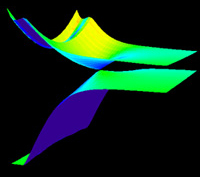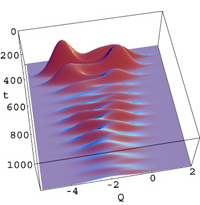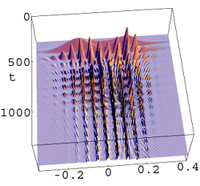Ab initio quantum chemistry, theory of femtochemistry, theory of femtosecond nonlinear spectroscopy of molecules
Prof. W. Domcke, Theoretical Chemistry, TUM
The research efforts of the group are focussed on the theoretical exploration of chemical dynamics induced by femtosecond or sub-femtosecond laser pulses in isolated polyatomic molecules as well as in chromophores in solution. The theoretical foundations of the detection of the photochemical dynamics via nonlinear optical spectroscopy with the highest possible temporal and spatial resolution are elaborated.
1. Electronic structure of excited states, potential-energy surfaces and reaction paths
 Fig. 1. Conical intersection of the S0
Fig. 1. Conical intersection of the S0
and S1 potential-energy surfaces of
pyrrole.
Methods of ab initio quantum chemistry are applied to characterize excited-state structures, reaction paths and topographical features of multi-dimensional electronic potential-energy surfaces of molecules. Of particular interest are conical intersections of potential-energy surfaces which are the key features for ultrafast (femtosecond) chemical processes. Photochemically relevant conical intersections and the reaction paths leading to them are explored with multi-reference ab initio electronic-structure methods for molecules of outstanding chemical interest, such as aromatic molecules, polyenes, amino acids and DNA bases.
2. Femtosecond dynamics at conical intersections
 Fig. 2. Time-dependent electronic-
Fig. 2. Time-dependent electronic-
nuclear wave packet of a photoinduced
electron-transfer reaction.
The specific features of ultrafast chemical dynamics at conical intersections of electronic potential-energy surfaces are explored via the numerical solution of the time-dependent Schrödinger equation or Liouville-von-Neumann equation. Our investigations of primary excited-state reaction mechanisms of polyenes, aromatic molecules and typical biomolecules have contributed to the recognition of the key mechanistic role of conical intersections in photochemistry. Of particular interest for the future work are the mechanisms which ensure the photostability of the building blocks of life (amino acids and DNA bases) via the ultrafast (femtosecond or sub-femtosecond) deactivation of the UV absorbing 1ππ* excited states.
3. Fundamentals of the detection of chemical dynamics via femtosecond nonlinear optics
 Fig. 3. Time and frequency resolved
Fig. 3. Time and frequency resolved
fluorescence spectrum generated by a
short pump pulse in a nonadiabatic
electron-transfer system.
Basic as well as applied aspects of the monitoring of the photochemical dynamics of polyatomic molecules by time- and frequency-resolved nonlinear spectroscopy are theoretically analyzed. Both the established formalism of nonlinear optics, which is perturbative in the strength of the laser fields, as well as novel nonperturbative formulations are developed in the context of specific systems of outstanding chemical interest. Calculations of pump-probe transient transmittance spectra, time- and frequency-resolved fluorescence spectra as well as femtosecond photoelectron spectra of complex molecular systems are performed. These studies provide insight which experimental conditions (in particular, carrier frequency, duration, shape, coherence, etc. of the laser pulses) are required for the optimal detection of the fundamental observables of the chemical dynamics.
Representative references
- A. L. Sobolewski, W. Domcke, C. Dedonder-Lardeux and C. Jouvet, Phys. Chem. Chem. Phys. 4, 1093 (2002).
- V. Vallet, Z. Lan, S. Mahapatra, A. L. Sobolewski and W. Domcke, J. Chem. Phys. 123, 144307 (2005).
- D. Egorova, M. F. Gelin and W. Domcke, J. Chem. Phys. 122, 134504 (2005).
Lectures for the Max Planck Research School
Time-dependent quantum dynamics of molecular systems
Lecturer: Wolfgang Domcke, lecture, 3+1 hours/week
Content:
The successes of femtosecond time-resolved optical and IR spectroscopy have lead to a profound reshaping of the conceptual basis of chemical reaction dynamics. Concepts like spatially localized wave packets following approximately classical trajectories have largely replaced the previously prevailing descriptions of chemical dynamics in terms of rate processes. This lecture develops fundamental concepts such as electronic or atomic wave packets or time-dependent semiclassical approximations for the time-dependent Schrödinger and Liouville-von-Neumann equations. Important aspects of quantum dissipative dynamics (energy and phase relaxation, electronic decay, unimolecular decay) are discussed in a systematic manner. Ultrafast nonadiabatic electronic dynamics at conical intersections of molecular potential-energy surfaces is discussed in some detail. The concepts are illustrated by the discussion of chemical processes of general interest, such as electron transfer, proton transfer, intramolecular vibrational relaxation and electronic radiationless decay.
Related Textbooks:
G. C. Schatz and M. A. Ratner, Quantum Mechanics in Chemistry (Prentice Hall, London, 1993). R. Schinke, Photodissociation Dynamics (Cambridge UP, Cambridge, 1993).
W. Domcke, D. R. Yarkony and H. Köppel (Eds.) Conical Intersections: Electronic Structure, Dynamics and Spectroscopy (World Scientific, Singapore, 2004).
Molecular dynamics in chemistry and biology
Lecturer: Wolfgang Domcke + Eberhard Riedle + Wolfgang Zinth (3+1 hours/week)
Content:
Dynamic processes in molecules: relaxation processes after the excitation of selected degrees of freedom. Electronic relaxation processes, vibrational relaxation and interaction with the environment. Experimental methods for the determining the reaction dynamics and the time dependent state population: from femtoseconds to microseconds. Photochemical processes: proton transfer, electron transfer, solvation, isomerization, dissociation and recombination. Photobiology: primary processes of photosynthesis and vision, dynamics of sensors, protein folding, energy and charge transfer in complex structures.
